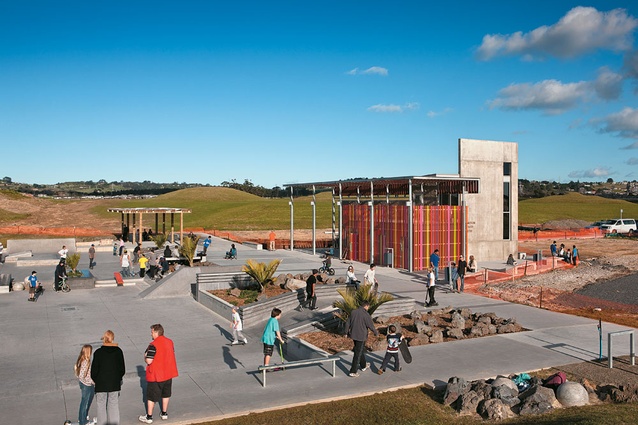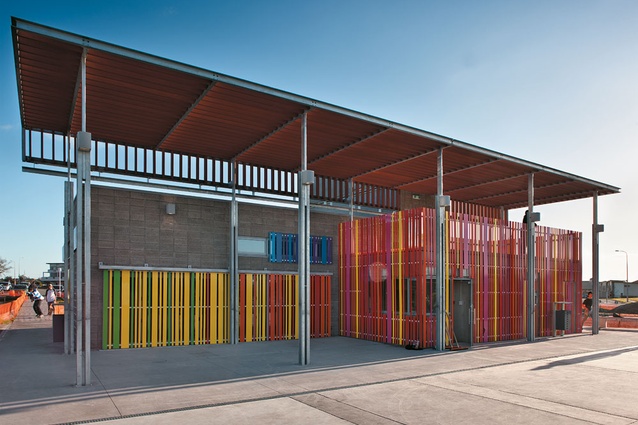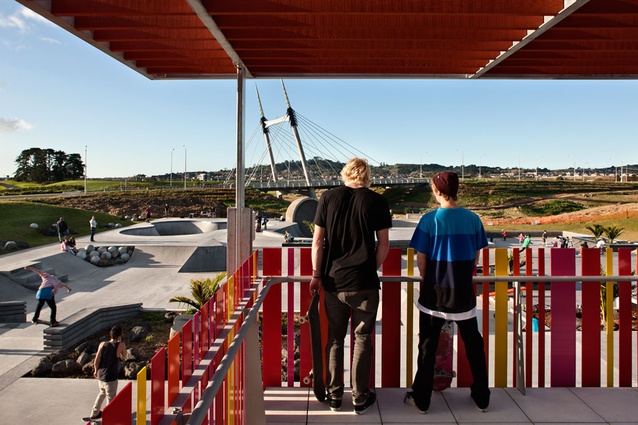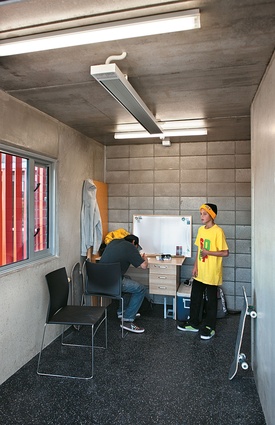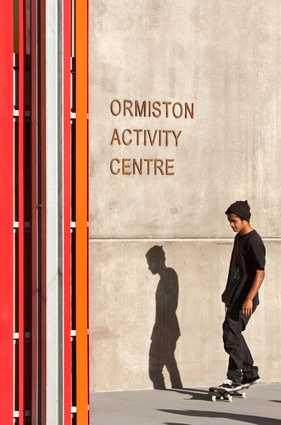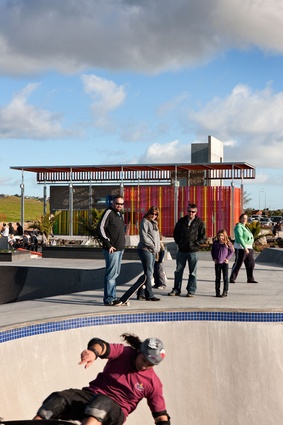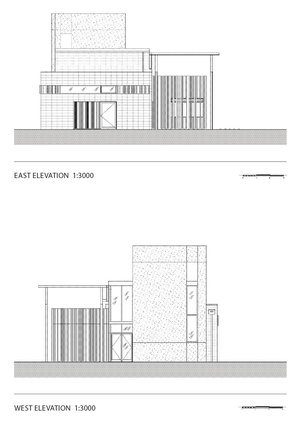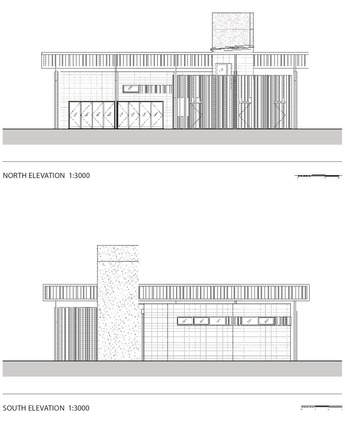Ormiston Activity Centre
It’s true that bright colours can’t rescue a dumb building, but they can at least save it from obscurity. This nifty little box dressed up in a multi-coloured piupiu will help the architecturally interested discover Manukau’s newest town, Flat Bush. There’s plenty of awful residential development already there and 40,000 people are expected to be in the neighbourhood by 2020. Those folks will pretty much be staying there, given how poorly served the area is by public transport. Right now, Auckland Council is in the process of bestowing amenities on the area. First up was the adjacent skatepark, which opened a year ago after a process of community consultation largely consisting of a Facebook page for posting feedback on the design. The resulting bowl seems a success, though a lot of would-be skaters are getting lost trying to find it.
Archoffice’s $595,000 technicolour dreamcoated structure can help with that. It’s a beacon in the wilderness of the 94-hectare Barry Curtis Park, or as the architects’ Developed Design Report has it, “It will act as a marker to denote gateway, end of axis and assist with orientation within the park”. Mrs April Ormiston, whose father-in-law had a 163-hectare dairy farm on the land during the 1920s, attended the opening on Saturday 30 April 2011 and lent the family name to the building. Her opinion of the architecture is not recorded, but it is clear that she is not of the demographic to which it is intended to appeal. Even though it is not the hoped-for skateshop or café, it’s clear that the skaters think it’s a sweet spot for a pit stop. It’s a flexible and economical design: the roof over the toilet block doubles as a platform for anxious caregivers to unobtrusively keep an eye on reckless offspring skating below. From up there, they can take in the fine view of New Zealand’s first cable-stayed bridge and avoid looking at the brand new ‘McMansions’ nearby. An official skatepark supervisor enjoys an office on the ground floor of the Activity Centre as a base for organising such necessary diversions as the forthcoming South and East Regional skateboarding competition and school holiday ‘how to skateboard’ sessions for under 10s and girls.
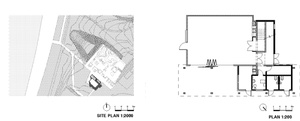
Beyond that, the 194m2 building opens out into a flat, undifferentiated space with a high ceiling and a kitchenette at one end. Windows set high in the stack bonded block walls to the south, east and north admit natural light to counteract the concrete bunker feel. Auckland Council’s publicity unintentionally invokes the rhetoric of government community centre literature of the post-war period in its list of prospective uses: “Art classes, facilities for youth, senior events and one-off functions”. Up to 80 people can be squeezed into this meeting room, but bookings have so far been scarce. It may be more appealing in summer when the coloured steel screens on the exterior north wall are shunted back to magically reveal three glass sliding doors.
Comprising four discrete volumes – stair tower, meeting room, toilets and viewing platform – the composition of the building takes its inspiration from building blocks. Raiding the toybox has always been a valid architectural strategy, and makes sense here where the building is readable from a distance by traffic flashing by on the main road. It’s a more gregarious younger sibling for the sober and mysterious cedar and concrete facility on Stancombe Road, designed by the same architects, and is careful to emphasise the family connection with its pre-cast concrete tower. For now, the Ormiston Activity Centre is all about its rainbow look. Steel verticals of varying thickness like the lines of a barcode are coated in three pure colours, with secondary and tertiary colours gatecrashing the party in a reference to the range of hues in digital age graphics. Rather than primary colours (considered too young, and too much of a preschool aesthetic) the cyan, magenta, yellow and key black or CMYK palette derives from skater apparel. Those skaters won’t be fooled by the cladding’s kaleidoscopic rendition of the colour wheel. It’s obvious that while there are breakpoints in the bar (and they are less intense around the window openings), all that colourful interference disguises the function of providing a protective shield against vandalism and graffiti.
Double duty then for the dressing: looking playful and acting tough. The clumping of the colour also helps define the architectural elements – blue over the upper window, green and yellow for the glass sliding door below. Stripes of red, orange and magenta form a double height palisade around what is referred to as the ‘extrovert’ part of the building to the stairs. All this fragmentation serves to break up the mass, while the repetition of yellow stripes provides the necessary linkages. Public facilities in parks often seem less like shelters than bunkers. In contrast to that, Ormiston Activity Centre is conspicuously welcoming. It shouts out across the vast landscape of Barry Curtis Park, announcing loud and proud to the skate crew that this is home.

